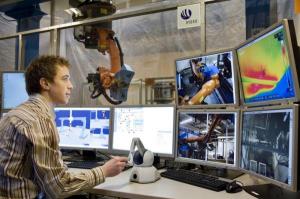Robotic Oil Drilling Platforms

 By 2015 several oil drilling platforms off the coast of Norway will be remotely operated by human operators on land, and robots on the platform.
By 2015 several oil drilling platforms off the coast of Norway will be remotely operated by human operators on land, and robots on the platform.The project is being funded by StatoilHydro, a Norwegian company. The goal is to reduce costs and dangers to oil workers on the rig. Researchers at a new laboratory in Trondheim will spend the next several years developing the software to control the robots. Automating the platforms will allow small and mid-sized oil fields to be exploited due to the reduced costs.
"If we can automate our platforms, we will have an alternative to
subsea platforms,” says Anders Røyrøy in StatoilHydro. “Both
technologies are aimed at small and medium-sized field which are not
exploited today because it is not profitable to use normal manned
platforms. An automated platform doesn't need personnel, and therefore
neither does it need fire systems, sound insulation, catering or a
whole range of other installations. Automated platforms also have
another advantage: whereas subsea systems statistically only manage to
recover about 45 percent of the oil or gas in a reservoir, a topside
platform can take out almost 55 percent. And then, maintenance at the
surface is much simpler."
There's some more info at the ZDNet Emerging Technology Trends blog.
[Via Slashdot]
Thanks for helping to keep our community civil!
Notify staff privately
You flagged this as spam. Undo flag.Flag Post
It's Spam
This post is an advertisement, or vandalism. It is not useful or relevant to the current topic.
This post is an advertisement, or vandalism. It is not useful or relevant to the current topic.
You flagged this as spam. Undo flag.Flag Post


